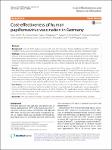Cost-effectiveness of human papillomavirus vaccination in Germany
Damm, Oliver
Horn, Johannes
Mikolajczyk, Rafael T.
Kretzschmar, Mirjam E. E.
Kaufmann, Andreas M.
Deleré, Yvonne
Ultsch, Bernhard
Wichmann, Ole
Krämer, Alexander
Greiner, Wolfgang
Background: The aim of this study was to assess the cost-effectiveness of human papillomavirus (HPV) vaccination in addition to the current cervical cancer screening programme in Germany using a dynamic transmission model. Methods: Based on a mathematical model simulating the transmission dynamics and the natural history of HPV infection and associated diseases (cervical intraepithelial neoplasia, cervical cancer, and genital warts), we estimated the epidemiological and economic consequences of HPV vaccination with both the quadrivalent and bivalent vaccines. In our base case analysis, we assessed the cost-effectiveness of vaccinating 12-year-old girls with a 3-dose schedule. In sensitivity analysis, we also evaluated the use of a 2-dose schedule and assessed the impact of vaccinating boys. Results: From a health care payer perspective, incremental cost-effectiveness ratios (ICERs) of a 3-dose schedule were €34,249 per quality-adjusted life year (QALY) for the bivalent and €14,711 per QALY for the quadrivalent vaccine. Inclusion of indirect costs decreased ICERs by up to 40%. When adopting a health care payer perspective, ICERs of a 2-dose approach decreased to €19,450 per QALY for the bivalent and to €3645 per QALY for the quadrivalent vaccine. From a societal perspective, a 2-dose approach using the quadrivalent vaccine was a cost-saving strategy while using the bivalent vaccine resulted in an ICER of €13,248 per QALY. Irrespective of the perspective adopted, additional vaccination of boys resulted in ICERs exceeding €50,000 per QALY, except for scenarios with low coverage (20%) in girls. Conclusions: Our model results suggest that routine HPV vaccination of 12-year-old girls with three doses is likely to be cost-effective in Germany. Due to the additional impact on genital warts, the quadrivalent vaccine appeared to be more cost-effective than the bivalent vaccine. A 2-dose schedule of the quadrivalent vaccine might even lead to cost savings when adopting a societal perspective. The cost-effectiveness of additional vaccination of boys was highly dependent on the coverage in girls.
Files in this item
No license information

